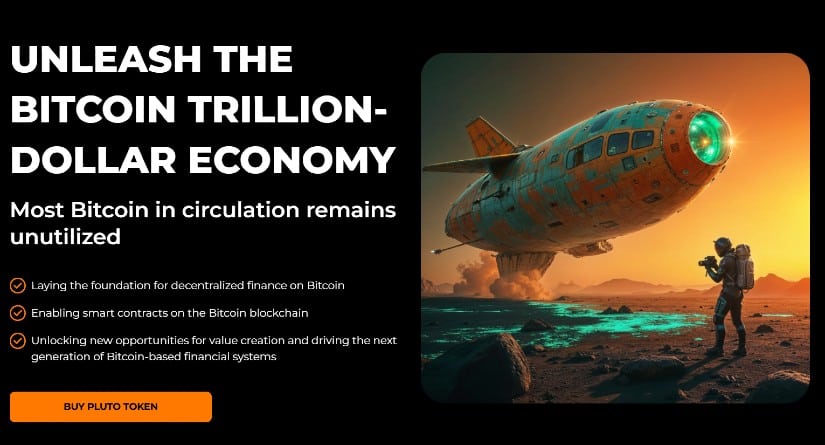This remarkable growth occurred on November 5, and Cardano has now stabilized at around $650 million in TVL.
The crypto market’s impressive bullish rally and Cardano’s strong fundamentals have pushed the asset’s total value locked (TVL) to over $700 million.
Nonetheless, these latest moves prove Cardano’s growing importance in the decentralized finance (DeFi) ecosystem and the level of trust placed in it by developers and investors. Additionally, there are new projects, like PlutoChain ($PLUTO), that could also improve Bitcoin’s presence in DeFi. With its hybrid Layer 2 blockchain, it could solve Bitcoin’s scalability issues and unlock new use cases.
Let’s see the details below.
Cardano DeFi Ecosystem Surpasses $700 Million in TVL
Cardano’s rise past $700 million in TVL is a testament to its steady progress and growing utility.

This achievement is fueled by the addition of new DeFi protocols that provide a wide range of services, from staking and lending to decentralized exchanges (DEX).
These types of innovations generate liquidity on the network and increase its attractiveness to both developers and users.
One of the notable features of Cardano is its focus on scalability and sustainability.
Unlike older blockchains like Ethereum, Cardano uses a unique proof-of-stake mechanism that reduces energy consumption while maintaining security.
Tools like the Plutus smart contract framework make it easier for developers to build on top of the platform, bringing more decentralized applications and users (dApps), further strengthening TVL.
Recent projects like Minswap, a decentralized exchange, and Indigo Protocol, a synthetic asset platform, are key contributors to this growth.
These applications not only gain users, but also demonstrate the practical usefulness of the Cardano ecosystem.
Additionally, innovations such as Hydra, a layer 2 scaling solution, address common blockchain issues such as network speed and congestion.
Another factor behind Cardano’s rise is its active and diverse community. From grassroots supporters to institutional investors, the network’s commitment to decentralization and sustainability resonates with a wide audience.
This growing interest is helping Cardano attract liquidity, developers, and attention in a highly competitive DeFi space.
As of December 12, 2024, ADA was trading at approximately $1.08. This price reflects a 65.04% decline from its all-time high of $3.09, recorded on September 2, 2021.
What future for ADA?
Looking ahead, Cardano’s $700 million TVL milestone appears to be just the beginning. With more protocols and partnerships on the horizon, the ecosystem is poised to grow further.
Analysts, like Dan Gambardello, expect its total value locked (TVL) to continue to increase as more decentralized applications (dApps) and DeFi protocols deploy on the network.
As developers continue to explore new use cases and the network improves its infrastructure, Cardano is gaining momentum to become a dominant force in decentralized finance.
Could PlutoChain’s Layer 2 ($PLUTO) solution be a bridge between Bitcoin and Ethereum?
PlutoChain ($PLUTO) is a new project that could connect the best of two massive blockchain ecosystems: Bitcoin and Ethereum.
With its innovative Layer 2 solution, this project could improve efficiency and, with the introduction of Ethereum Virtual Machine (EVM) compatibility, could allow developers to seamlessly combine the strengths of both networks.

A notable feature of PlutoChain is its potential to expand Bitcoin’s role in decentralized finance (DeFi). While Bitcoin has traditionally served as a store of value, its DeFi applications have been limited.
PlutoChain has the potential to change this by leveraging Bitcoin’s strong security while enabling support for smart contracts and decentralized applications (dApps).
This could open the door to new use cases and expand Bitcoin’s usefulness significantly.
Bitcoin’s well-known challenges, such as high transaction fees and scalability limitations, could also find solutions through the project’s optimized layer 2 transaction system.
By reducing costs and improving scalability, this could make Bitcoin more practical for everyday use and attractive to various industries.
PlutoChain has also undergone comprehensive security audits by SolidProof and Assure DeFi, two trusted names in blockchain security.

Final Thoughts: Is PlutoChain the Key to Bitcoin’s Blockchain and DeFi Transformation?
PlutoChain could address some of Bitcoin’s biggest challenges: high costs and limited interoperability between networks.
With its idea of combining the unparalleled reliability of Bitcoin with the flexibility of Ethereum, it has the potential to redefine Bitcoin’s role in DeFi.
If you want to know more, you can participate in discussions on platforms like Twitter, Discord and Telegram.
Visit the links below to learn more about PlutoChain and its unique features:
Official website: https://plutochain.io
Page X/Twitter: https://x.com/plutochain/
Telegram channel:
Please remember that this article is purely informational and not financial advice. All cryptocurrencies are volatile, with prices subject to rapid change. Always do your own research and consult an expert before joining any crypto company. We are not responsible for the results based on the information contained in this article. Forward-looking statements involve risks and may not reflect current updates.
This is a sponsored post. The opinions expressed are solely those of the sponsor and readers should conduct due diligence before taking any action based on the information presented in this article.

